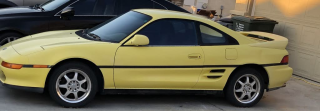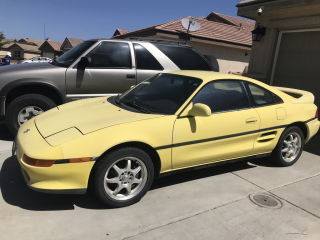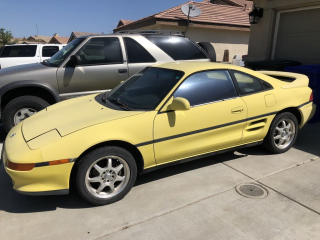The 1992 Toyota MR2, part of the second generation (SW20), is a compact, rear-wheel-drive sports car celebrated for its mid-engine layout and striking, modern design. Produced from 1989 to 1999, key trims included the naturally aspirated and turbocharged models. Its popularity stems from offering supercar-like handling and performance at a more accessible price point, making it a favorite among enthusiasts.
The Good
The 1992 MR2 boasts thrilling mid-engine handling, Toyota's legendary reliability, and an iconic, timeless design. Its accessible performance appeals to driving enthusiasts, while its fuel efficiency and robust engineering offer practical, long-term value.
The Bad
Common concerns for the 1992 MR2 include potential turbo issues (especially on turbocharged models), oil leaks, suspension wear, and the infamous "snap oversteer" in earlier models due to its mid-engine design. Rust can also be a significant issue.
1992 Toyota MR2: Quick Overview
- Engine Options: The 1992 Toyota MR2 came with two primary engine options for the US market:
- 2.2L naturally aspirated 5S-FE inline-4
- 2.0L turbocharged 3S-GTE inline-4 (only on Turbo models)
- Horsepower:
- 5S-FE: Approximately 130-135 horsepower
- 3S-GTE: Approximately 200-214 horsepower (depending on specific market and tune)
- Fuel Economy: Varies with engine and transmission, but generally in the range of:
- Naturally Aspirated: 20-24 MPG city / 26-30 MPG highway
- Turbocharged: 18-22 MPG city / 24-28 MPG highway
- 0-60 Times:
- Naturally Aspirated: Around 8-9 seconds
- Turbocharged: Around 6-7 seconds
- Towing Capacity: Not applicable. The MR2 is a sports car and not designed for towing.
- Trim-Level Features:
Non-Turbo (e.g., MR2):
- Standard rear-wheel drive, mid-engine layout
- Power steering, windows, locks
- Cloth interior
- Removable T-top roof panels
- 14-inch steel wheels
- All features of the non-turbo model plus:
- More powerful 3S-GTE engine
- Larger brakes
- Sport-tuned suspension
- 15 or 16-inch alloy wheels
- Optional leather seats
- Rear spoiler
- Limited-slip differential (often standard or available)
- Air conditioning
- Premium audio system
- Anti-lock Braking System (ABS)
1992 Toyota MR2 Specifications
Vehicle Information
| Year | 1992 |
| Make | Toyota |
| Model | MR2 |
| Trim | - |
| Style | Coupe 5-Speed Manual |
| Type | Coupe |
| Category | Sports Car |
Manufacturing Details
| Made In | Japan |
| Manufacturing City | - |
Dimensions
| Doors | 2-Door |
| Curb Weight | 2599 pounds |
| Gross Vehicle Weight Rating | - |
| Overall Height | 48.60 inches |
| Overall Length | 164.20 inches |
| Overall Width | 66.90 inches |
| Wheelbase Length | 94.50 inches |
| Standard Seating | 2 |
Engine & Performance
| Engine | 2.2-L L-4 DOHC 16V |
| Engine Size | 2.2L |
| Engine Cylinders | 4 |
| Transmission | 5-Speed Manual |
| Transmission Type | Manual |
| Transmission Speeds | 5-Speed |
| Drivetrain | Rear-Wheel Drive |
Additional Features
| Anti-Brake System | Non-ABS 4-Wheel ABS |
| Steering Type | Rack & Pinion |
Pricing
| Manufacturer Suggested Retail Price (MSRP) | $17,658 |
| Invoice Price | - |
| Delivery Charges | - |
Vehicle History Report
Vehicle
Specifications
Specifications
Ownership
History
History
All History
Events
Events
NMVTIS Title
History Check
History Check
Salvage/Rebuilt
Check
Check
Accident
Check
Check
Theft
Check
Check
Open Lien
Check
Check
Past Sale
Listings
Listings
Safety
Recalls
Recalls
Odometer
Check
Check
Market Price
Analysis
Analysis
What Problems Does the 1992 Toyota MR2 Have?
The 1992 Toyota MR2, while generally reliable due to Toyota's engineering, has a few common issues that owners and potential buyers should be aware of. A significant concern, especially for turbocharged models, is the durability of the 3S-GTE engine's turbocharger. Over time, these can fail, leading to costly repairs. Oil leaks, particularly from the oil cooler seals and valve cover gaskets, are also frequently reported. Another point of attention is the potential for "snap oversteer," a characteristic of mid-engine cars that can make them prone to oversteer if the driver is not careful or if the suspension setup is compromised. This was more prevalent in earlier years of the second generation, but caution is still advised. Suspension components, such as bushings and ball joints, are subject to wear and tear, especially on higher-mileage vehicles, and can affect handling and comfort. Rust is a major concern for MR2s, particularly in areas with harsh winters or high humidity. Look for rust in the wheel wells, rocker panels, and around the suspension mounting points. Electrical gremlins, while less common, can occur, often related to aging wiring harnesses or components like the power window regulators. Toyota has issued recalls for various vehicles over the years, and while specific recalls for the 1992 MR2 might be limited and may have been addressed, it is always prudent to check for any outstanding recalls with a VIN lookup. Long-term reliability is largely dependent on how well the car has been maintained. Those with consistent maintenance records, particularly oil changes and timing belt replacements, tend to fare much better. Cars that have been driven hard or neglected are more likely to exhibit problems. The transmission, while robust, can also develop issues with worn synchros if driven aggressively or not maintained. The clutch is another wear item to consider. For 1992 specifically, this model year falls within the early part of the second generation, so some of the initial design quirks might still be present, though significant improvements were made over the production run.
How long will the 1992 Toyota MR2 last?
The 1992 Toyota MR2, with diligent maintenance, can achieve well over 200,000 miles. Many owners report their MR2s still running strong with mileage exceeding 250,000 miles. The long-term durability is a testament to Toyota's robust engineering, particularly the 5S-FE naturally aspirated engine, which is known for its longevity. The 3S-GTE turbocharged engine, while more powerful, requires more meticulous care to reach similar high mileage due to the added stress of turbocharging. Key to long-term survival is regular oil changes, timely replacement of wear items like belts and hoses, and addressing any rust issues promptly. Weaknesses that can shorten service life include neglected maintenance, especially on the turbo model, and allowing rust to take hold, which can compromise structural integrity. With proper care, the MR2 offers decades of enjoyment.
What Technology & Safety Features are Included?
The 1992 Toyota MR2, being a sports car from the early 90s, features a rather modest suite of technology and safety features by modern standards. Built-in tech was primarily focused on the driving experience rather than infotainment. Standard entertainment typically included a basic AM/FM radio with a cassette player, often with two speakers. Higher trim levels or optional packages might have offered a more advanced stereo system with more speakers and potentially a graphic equalizer.()
Driver-assistance features were virtually non-existent in the modern sense. The primary "assistance" was the power steering system, which was well-tuned for the car's handling characteristics. Anti-lock Braking System (ABS) was an optional feature on many models, enhancing braking control, particularly in emergency situations.()
Safety features for the 1992 MR2 included standard three-point seatbelts and a reinforced passenger cell. Side-impact door beams were also part of the safety structure. Airbags were not standard equipment on all models in 1992 for the MR2; they became more common and standard later in the generation. The car's mid-engine layout also contributed to its safety by allowing for a large crumple zone at the front.()
Crash-test ratings from this era are less standardized and readily available compared to today. However, the MR2 was designed with safety in mind for its time, and its sporty, low-slung profile with a robust chassis provided a degree of occupant protection. It's important to note that compared to contemporary vehicles, advanced safety systems like traction control, stability control, or numerous airbags were not part of the package. The emphasis was on the driving dynamics and fundamental structural safety. Optional features might have included cruise control and air conditioning, which were considered luxuries by some at the time.
Driver-assistance features were virtually non-existent in the modern sense. The primary "assistance" was the power steering system, which was well-tuned for the car's handling characteristics. Anti-lock Braking System (ABS) was an optional feature on many models, enhancing braking control, particularly in emergency situations.()
Safety features for the 1992 MR2 included standard three-point seatbelts and a reinforced passenger cell. Side-impact door beams were also part of the safety structure. Airbags were not standard equipment on all models in 1992 for the MR2; they became more common and standard later in the generation. The car's mid-engine layout also contributed to its safety by allowing for a large crumple zone at the front.()
Crash-test ratings from this era are less standardized and readily available compared to today. However, the MR2 was designed with safety in mind for its time, and its sporty, low-slung profile with a robust chassis provided a degree of occupant protection. It's important to note that compared to contemporary vehicles, advanced safety systems like traction control, stability control, or numerous airbags were not part of the package. The emphasis was on the driving dynamics and fundamental structural safety. Optional features might have included cruise control and air conditioning, which were considered luxuries by some at the time.
What Colors Options are Available?
1992 Toyota MR2 Prices and Market Value
When new, the 1992 Toyota MR2 had a sticker price ranging from approximately $18,000 for the base naturally aspirated model to around $24,000 for the Turbo model. As a sports car, it experienced depreciation typical of its segment, but it has since stabilized and even appreciated in value for well-maintained examples. Current used market prices for the 1992 MR2 can range widely, from $3,000-$5,000 for cars needing significant work, to $8,000-$15,000 for good to excellent condition naturally aspirated models. Turbo models in pristine condition, especially those with low mileage and original parts, can fetch $15,000 and upwards. Factors affecting resale value include mileage, condition (especially rust and mechanical soundness), originality of parts, and whether it's a desirable Turbo model. Enthusiast demand keeps values strong for well-preserved examples.
1992 Toyota MR2 Cost of Ownership
Owning a 1992 Toyota MR2 can be surprisingly economical for a sports car, especially naturally aspirated models. Insurance costs are moderate, varying by driver profile and location, but generally less than more exotic sports cars. Fuel economy is decent for its performance, with the naturally aspirated engine offering good MPG. Maintenance is straightforward and parts are generally available, though some specialized turbo components can be pricier. Repair costs can be average, but specialized knowledge may be needed for turbo issues. Overall, with proper care, the MR2 is a cost-effective way to enjoy a mid-engine sports car, particularly when compared to its contemporaries. It's neither excessively economical nor overly costly to own, striking a good balance.
1992 Toyota MR2 Fuel Efficiency
Fuel Type
Gasoline
Fuel Capacity
14.30 gallons
City Mileage
21 miles/gallon
Highway Mileage
28 miles/gallon
1992 Toyota MR2 Safety Rating
NHTSA
IIHS
1992 Toyota MR2 Warranty
Basic
Original warranty
0 months / No data
Estimated remaining
Expired
Powertrain
Original warranty
0 months / No data
Estimated remaining
Expired
Rust
Original warranty
0 months / No data
Estimated remaining
Expired
1992 Toyota MR2 Insurance
Insurance for a 1992 Toyota MR2 is moderately priced, reflecting its status as a Coupe with strong safety ratings and
reasonable repair costs.
reasonable repair costs.
How Does the 1992 Toyota MR2 Compare to Other Coupe?
The 1992 Toyota MR2 competed in a segment with formidable rivals. In terms of performance and handling, it stood toe-to-toe with cars like the Mazda MX-5 Miata (NA), Nissan 300ZX (Z32), and the Mitsubishi 3000GT VR-4. The MR2's mid-engine layout gave it a distinct handling advantage, particularly in cornering agility, often surpassing the front-engine MX-5 Miata in this regard, though the Miata offered a more raw, open-top driving experience. The 300ZX and 3000GT offered more power and luxury features, especially in their twin-turbo variants, but at a significantly higher price point and with more complex mechanicals that could lead to higher maintenance costs.()
When it comes to reliability, Toyota's reputation shines. The MR2 generally outperformed the more complex Z32 300ZX and 3000GT, which were known for intricate electronic systems and twin-turbo setups that could be prone to issues. The Mazda Miata is also renowned for its reliability, often considered on par with the MR2, though perhaps with fewer major mechanical quirks to watch out for compared to the MR2's turbo variant.
Features in the 1992 MR2 were functional and driver-focused, typical of its era. Rivals like the 300ZX and 3000GT often boasted more advanced technology and creature comforts, such as more sophisticated audio systems, digital climate control, and available leather interiors. The MR2, especially in base trim, was more spartan, emphasizing the driving experience.
Price-wise, the MR2 offered exceptional value. It provided a taste of exotic mid-engine performance at a price considerably lower than more powerful competitors like the 300ZX Twin Turbo or 3000GT VR-4. The MX-5 Miata was often priced similarly or slightly lower, offering a different, more convertible-focused sports car experience.
Alternatives:
* Mazda MX-5 Miata (NA): Similar price, excellent reliability, lighter and more agile, but less powerful and no factory turbo option. Offers a true convertible experience.
* Nissan 300ZX (Z32): More powerful (especially Twin Turbo), more luxury features, but significantly more expensive and complex, leading to higher maintenance costs.
* Mitsubishi 3000GT VR-4: AWD, active aero, powerful twin-turbo, but very complex and costly to maintain. A grand tourer rather than a pure sports car.
* Porsche 944: Similar front-engine, rear-drive layout with excellent handling and build quality, but often higher price and maintenance costs. A solid alternative if found in good condition.
For its blend of performance, reliability, and accessible pricing, the 1992 MR2 remains a compelling choice, especially if spirited driving dynamics are the priority.
When it comes to reliability, Toyota's reputation shines. The MR2 generally outperformed the more complex Z32 300ZX and 3000GT, which were known for intricate electronic systems and twin-turbo setups that could be prone to issues. The Mazda Miata is also renowned for its reliability, often considered on par with the MR2, though perhaps with fewer major mechanical quirks to watch out for compared to the MR2's turbo variant.
Features in the 1992 MR2 were functional and driver-focused, typical of its era. Rivals like the 300ZX and 3000GT often boasted more advanced technology and creature comforts, such as more sophisticated audio systems, digital climate control, and available leather interiors. The MR2, especially in base trim, was more spartan, emphasizing the driving experience.
Price-wise, the MR2 offered exceptional value. It provided a taste of exotic mid-engine performance at a price considerably lower than more powerful competitors like the 300ZX Twin Turbo or 3000GT VR-4. The MX-5 Miata was often priced similarly or slightly lower, offering a different, more convertible-focused sports car experience.
Alternatives:
* Mazda MX-5 Miata (NA): Similar price, excellent reliability, lighter and more agile, but less powerful and no factory turbo option. Offers a true convertible experience.
* Nissan 300ZX (Z32): More powerful (especially Twin Turbo), more luxury features, but significantly more expensive and complex, leading to higher maintenance costs.
* Mitsubishi 3000GT VR-4: AWD, active aero, powerful twin-turbo, but very complex and costly to maintain. A grand tourer rather than a pure sports car.
* Porsche 944: Similar front-engine, rear-drive layout with excellent handling and build quality, but often higher price and maintenance costs. A solid alternative if found in good condition.
For its blend of performance, reliability, and accessible pricing, the 1992 MR2 remains a compelling choice, especially if spirited driving dynamics are the priority.
Final Verdict: Is the 1992 Toyota MR2 a Good Coupe?
The 1992 Toyota MR2 is ideal for driving enthusiasts who appreciate sharp handling, a unique mid-engine layout, and Toyota's renowned reliability, all at a relatively affordable price point for a sports car. It's a fantastic choice for weekend fun or as a second car for those who value a pure driving experience over luxury or practicality.
It is absolutely worth buying, particularly if you find a well-maintained example. For most buyers, a naturally aspirated model offers the best balance of reliability and performance. The Turbo model is desirable for its power but demands more careful inspection and potentially higher maintenance costs. Buying used is the only option. Focus on cars with a documented maintenance history, minimal rust, and ideally, stock or period-correct modifications. A thoroughly inspected and maintained 1992 MR2 offers tremendous driving enjoyment and lasting value.
It is absolutely worth buying, particularly if you find a well-maintained example. For most buyers, a naturally aspirated model offers the best balance of reliability and performance. The Turbo model is desirable for its power but demands more careful inspection and potentially higher maintenance costs. Buying used is the only option. Focus on cars with a documented maintenance history, minimal rust, and ideally, stock or period-correct modifications. A thoroughly inspected and maintained 1992 MR2 offers tremendous driving enjoyment and lasting value.



